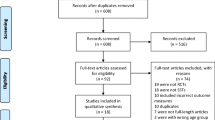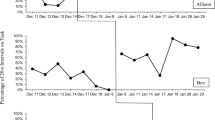Abstract
In a study with an elderly female subject, two behavioral treatments were evaluated in terms of their effectiveness in decreasing orofacial movement associated with tardive dyskinesia. Video feedback and discreet-discrete prompting, a self-control procedure using a portable audio signal generator, were compared by means of an alternating treatments experimental design. Video and instructional controls were included in the study. Results indicated that both procedures were effective in decreasing orofacial movement. In addition, during the concluding phase of the study, a prompting card was carried by the subject at all times as a reminder to control mouth movements on an ongoing basis. This concluding phase resulted in generalization of treatment effects to the nontreatment environment. Follow-up sessions indicated maintenance of treatment effects.
Similar content being viewed by others
References
Albanese, H., & Gaarder, K. (1977). Biofeedback treatment of tardive dyskinesia: Two case reports.American Journal of Psychiatry, 134(10), 1149–1150.
Barlow, D. H., & Hayes, S. C. (1979). Alternating treatments design: One strategy for comparing the effects of two treatments in a single subject.Journal of Applied Behavior Analysis, 12(2), 199–210.
Farrar, W. B. (1976). Using edlectromyographic biofeedback in treating orofacial tardive dyskinesia.Journal of Prosthetic Dentistry, 35 384–387.
Frederiksen, L. W., & Rosenbaum, M. S. (1979). The behavioral control of tardive dyskinesia: Evaluation of three types of feedback.Journal of Behavior Therapy and Experimental Psychiatry, 10(4), 299–302.
Jackson, G. M., & Schonfeld, L. I. (1982). Comparisons of visual feedback, instructional prompts, and discreet, discrete prompting in the treatment of orofacial tardive dyskinesia.International Journal of Behavioral Geriatrics, 1(2), 35–46.
Taylor, C. B., Zlutnick, S. I., & Hoehle, W. (1979). The effects of behavioral procedures on tardive dyskinesia.Behavior Therapy, 10, 37–45.
Author information
Authors and Affiliations
Additional information
Appreciation is expressed to the staff of the Community Aging Program, Ann Freed, Nancy Suarez, and Stephanie Jackson for their assitance.
Rights and permissions
About this article
Cite this article
Jackson, G.M., Schonfeld, L.I. & Griffith, K. A comparison of two behavioral treatments in decreasing the orofacial movement of tardive dyskinesia. Biofeedback and Self-Regulation 8, 547–553 (1983). https://doi.org/10.1007/BF00998762
Issue Date:
DOI: https://doi.org/10.1007/BF00998762




